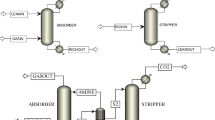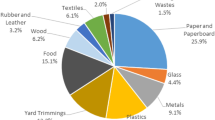Abstract
This paper extends a previous investigation on the thermal behavior of CH4-CPO reformers with honeycomb catalysts. Modeling and experimental studies on the short contact time catalytic partial oxidation (CPO) of CH4 to syngas from our and from other groups have shown that Rh-catalysts rapidly deactivate at the very high temperatures, close to 1000 °C, that establish in the inlet zone of the reactor. We have previously shown that a significant reduction of the surface hot-spot temperature can be obtained by properly designing the catalyst: beneficial effects are observed at increasing opening of the honeycomb channels, which decreases the rate of O2 inter-phase mass transfer, and at increasing catalyst activity, which promotes the rate of the endothermic reactions. In this work, we explore the effect of the reactor configuration, namely the effect of heat dispersion from the glowing front face of the monolith. Three reactor configurations were compared in CH4-CPO experiments: (i) a configuration with perfect continuity between the front heat shield (FHS) and the catalytic module, which behaved close to an ideal adiabatic reactor, (ii) a configuration where the FHS was separated from the catalytic monolith and (iii) a configuration where the FHS was at large distance from the catalytic module. State of the art experimental tools, including the spatially resolved measurement of temperature and concentration profiles were used to characterize the thermal behavior of the various configurations. Detailed kinetic modeling supported the analysis of data. The results showed that, at the expense of a small loss of thermal efficiency, a very moderate loss of performance in terms of conversion and selectivity, but, remarkably, an important reduction of the surface inlet temperatures were achieved. Preliminary experiments with propane/air mixtures suggest that the adoption of a moderately dispersive reactor can represent a promising solution for the stable operation of catalytic units treating heavier fuels than methane.




Similar content being viewed by others
References
Hickman DA, Schmidt LD (1992) J Catal 138:267
Hickman DA, Haupfear EA, Schmidt LD (1993) Catal Lett 17:223
Groppi G, Beretta A, Tronconi E (2006) In: Cybulski A Moulijn JA (eds) Structured catalysts and reactors, 2nd edn. CRC Press, Hoboken
York APE, Xiao TC, Green MLH, Claridge JB (2007) Catal Rev Sci Eng 49:511
Al-Harbi M, Epling WS (2009) Appl Catal B 89:315
Choudhary TV, Choudhary VR (2008) Angew Chem Int Edit 47:1828
Jones G, Jakobsen JG, Shim SS, Kleis J, Andersson MP, Rossmeisl J, Abild-Pedersen F, Bligaard T, Helveg S, Hinnemann B, Rostrup-Nielsen JR, Chorkendorff I, Sehested J, Nørskov JK (2008) J Catal 259:147
Heitnes K, Lindberg S, Rokstad OA, Holmen A (1995) Catal Today 24:211
Aartun I, Venvik HJ, Holmen A, Pfeifer P, Görke O, Schubert K (2005) Catal Today 110:98
Basini L, Guarinoni A, Aragno A (2000) J Catal 190:284
Basini L, Aasberg-Petersen K, Guarinoni A, Østberg M (2001) Catal Today 64:9
Horn R, Degenstein NJ, Williams KA, Schmidt LD (2006) Catal Lett 110:169
Horn R, Williams KA, Degenstein NJ, Schmidt LD (2006) J Catal 242:92
Horn R, Williams KA, Degenstein NJ, Bitsch-Larsen A, Dalle Nogare D, Tupy SA, Schmidt LD (2007) J Catal 249:380
Bitsch-Larsen A, Horn R, Schmidt LD (2008) Appl Catal A 348:165
Donazzi A, Michael BC, Schmidt LD (2008) J Catal 260:270
Michael BC, Donazzi A, Schmidt LD (2009) J Catal 265:117
Schwiedernoch R, Tischer S, Correa C, Deutschmann O (2003) Chem Eng Sci 58:633
Bizzi M, Saracco G, Schwiedernoch R, Deutschmann O (2004) AICHE J 50:1289
Maestri M, Beretta A, Groppi G, Tronconi E, Forzatti P (2005) Catal Today 105:709
Beretta A, Groppi G, Lualdi M, Tavazzi I, Forzatti P (2009) Ind Eng Chem Res 48:3825
Dalle Nogare D, Degenstein NJ, Horn R, Canu P, Schmidt LD (2008) J Catal 258:131
Dalle Nogare D, Degenstein NJ, Horn R, Canu P, Schmidt LD (2011) J Catal 277:134
Donazzi A, Maestri M, Michael BC, Beretta A, Forzatti P, Groppi G, Tronconi E, Schmidt LD, Vlachos DG (2010) J Catal 275:270
Tavazzi I, Beretta A, Groppi G, Maestri M, Tronconi E, Forzatti P (2007) Catal Today 129:372
Ding S, Yang Y, Jin Y, Cheng Y (2009) Ind Eng Chem Res 48:2878
Cimino S, Torbati R, Lisi L, Russo G (2009) Appl Catal A 360:43
Cimino S, Lisi L, Russo G, Torbati R (2010) Catal Today 154:283
Bitsch-Larsen A, Degenstein NJ, Schmidt LD (2008) Appl Catal B 78:364
Ding S, Cheng Y, Cheng Y (2010) Ind Eng Chem Res 50:856
Beretta A, Donazzi A, Livio D, Maestri M, Groppi G, Tronconi E, Forzatti P (2011) Catal Today. doi:10.1016/j.cattod.2011.03.081
Valentini M, Groppi G, Cristiani C, Levi M, Tronconi E, Forzatti P (2001) Catal Today 69:307
Beretta A, Donazzi A, Groppi G, Forzattl P, Dal Santo V, Sordelli L, De Grandi V, Psaro R (2008) Appl Catal B 83:96
Maestri M, Vlachos DG, Beretta A, Groppi G, Tronconi E (2009) AICHE J 55:993
Granata S, Faravelli T, Ranzi E (2003) Combust Flame 132:533
Shah RK, London AL (1978) Laminar flow forced convection in ducts. Academic Press, New York
Lee ST, Aris R (1977) Chem Eng Sci 32:827
Aartun I, Silberova B, Venvik H, Pfeifer P, Görke O, Schubert K, Holmen A (2005) Catal Today 105:469
Donazzi A, Livio D, Maestri M, Beretta A, Groppi G, Tronconi E, Forzatti P (2011) Angew Chem Int Edit 50:3943
Acknowledgments
The authors are grateful to Dr. Galen B. Fischer (University of Michigan) for useful discussions.
Author information
Authors and Affiliations
Corresponding author
Rights and permissions
About this article
Cite this article
Livio, D., Donazzi, A., Beretta, A. et al. Optimal Design of A CPO-Reformer of Light Hydrocarbons with Honeycomb Catalyst: Effect of Frontal Heat Dispersions on the Temperature Profiles. Top Catal 54, 866 (2011). https://doi.org/10.1007/s11244-011-9710-1
Published:
DOI: https://doi.org/10.1007/s11244-011-9710-1




